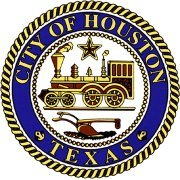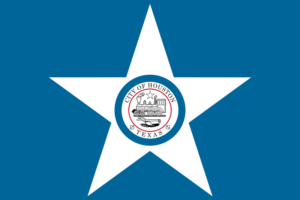In 1840, the Houston City Council, led by Mayor Charles Bigelow, authorized the creation of an official city seal. Dr. Francis Moore, Jr., a former state representative and former Houston mayor, enlisted a die-cutter from New York to produce the seal. The city council paid $50 for it.
The top portion of the original seal says, “City of Houston,” and the bottom was part was blank. By 1869, “Texas,” had been added on the bottom portion. The Lone Star represents the newborn nation of the west. The noble locomotive symbolizes Houston’s spirit of progress. The humble plow represents the agricultural empire of Texas from which Texas would acquire her wealth.
Putting the locomotive on the seal exemplifies looking toward the future. At the time of the seal’s adoption, no locomotive had been to Houston. Houston was not yet a seaport and the closest seaport was fifty miles away in Galveston. The Buffalo Bayou, Brazos, and Colorado Railway brought a used engine in 1852, and by 1882, there were 10 railroad lines in Houston.
The original seal apparently disappeared for a few years until found in 1939 by Mrs. Margaret Westerman, the assistant city secretary. The City Hall Annex is named after her.
The seal of the City of Houston is used in the city’s official flag. It consists of a blue background with a large five-pointed star in the center. The seal is placed within the star.
Mayor Ben Campbell, in 1915, organized a citywide contest for submissions for a Houston flag. The winner of the competition was Major W.A. Wheeldon. The original design, which was drawn by Mrs. J.W. Greenhill, Jr., used the coat of arms of Sam Houston’s family. The contest judges believed that adding the city seal made the flag express a vision of the future.
The growth of the cotton, rice, sugar cane, and timber industries helped to build the railroads, thus making Houston the major railroad center in the southwest. Through this growth, the 19th Century city fathers’ vision for Houston was realized.



